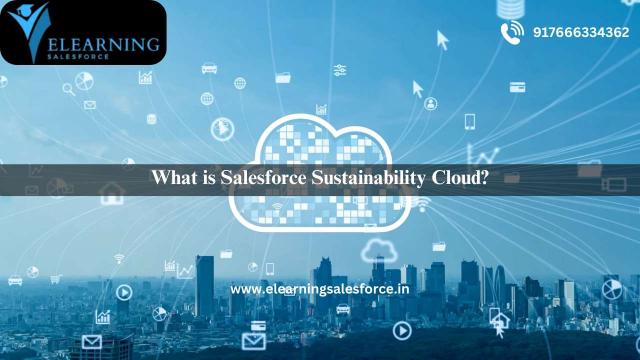Have you ever pondered how companies can both expand and have a beneficial environmental impact? Nowadays, sustainability is more than just a catchphrase; it’s a need. It is now simpler than ever to monitor, control, and lessen an organization’s environmental effect thanks to technologies like Salesforce Sustainability Cloud, which are helping businesses all over the world prioritize environmental responsibility. However, what is Salesforce Sustainability Cloud and why is it important? Let’s get started and investigate how this cutting-edge platform may assist people and companies in making the initial transition to sustainability.
Understanding Salesforce Sustainability Cloud
Fundamentally, Salesforce Sustainability Cloud is an effective platform made to assist companies in assessing, monitoring, and disclosing their environmental impact. It enables businesses to compile up-to-date information on their energy usage, carbon emissions, and other sustainability indicators in one location. The objective? to assist businesses in meeting their sustainability objectives and lowering their carbon footprint by using data to inform their decisions.
To put it simply, Sustainability Cloud gives companies the resources they need to oversee their sustainability initiatives, comply with environmental standards, and maintain their competitiveness in a world that is becoming more environmentally sensitive.
Key Features of Salesforce Sustainability Cloud
- Real-Time Carbon Footprint Tracking
Tracking a company’s carbon footprint in real-time is one of Sustainability Cloud’s most notable capabilities. By combining information from multiple sources, such as energy use and travel, into a single dashboard, it assists companies in understanding their environmental impact. - Data-Driven Insights
To assist firms in identifying patterns and areas where they may cut waste and emissions, the platform provides comprehensive analytics and reporting. For instance, Salesforce Sustainability Cloud can identify areas where energy-saving measures could be most successful if your business utilizes a lot of energy for operations. - Compliance and Reporting Made Easy
Maintaining compliance might be difficult due to the world’s increasingly stringent environmental rules. By automating the reporting process, Sustainability Cloud makes it simple for companies to comply with sustainability standards and give stakeholders clear reports. - Collaborative Features for Teams
Salesforce facilitates teamwork. Teams from all throughout the company may get together to discuss actionable findings, monitor progress, and create sustainable targets. This encourages a company-wide dedication to environmental objectives.
Why Is Sustainability Cloud Important?
1. Meeting Regulatory Requirements
Stricter environmental regulations are being introduced by governments worldwide, and businesses must abide with them. Businesses may keep ahead of requirements by accurately recording and reporting their environmental data with Sustainability Cloud.
2. Building Brand Loyalty
Today’s consumers are more aware of how a brand affects the environment. Businesses may increase brand loyalty and get a competitive edge by demonstrating to their customers that they care about the environment by utilizing Salesforce Sustainability Cloud.
3. Improving Operational Efficiency
Being “green” is only one aspect of sustainability; another is increasing operational effectiveness. Businesses may find operational inefficiencies, cut waste, and save money over time by utilizing Salesforce’s insights.
4. Empowering Employees
By using tools that promote sustainability, you empower your workforce to actively contribute to environmental goals. Employees feel more engaged when they see their company making a positive impact on the world.
Market Trends: Why Sustainability Matters Now More Than Ever
Sustainability is becoming more and more popular in today’s market, and it is not just a corporate obligation. Customers are increasingly selecting brands that reflect their ideals as they get more environmentally conscious. Actually, research indicates that 60–70% of customers are more inclined to support businesses that exhibit a dedication to sustainability.
Additionally, investors are starting to prioritize sustainable activities. Businesses that don’t put sustainability first run the danger of losing investors as environmental, social, and governance (ESG) factors become more ingrained in investment strategies.
At the nexus of these two important trends, Salesforce Sustainability Cloud helps companies meet their environmental targets while improving their standing in a market that prioritizes sustainability.
How to Get Started with Salesforce Sustainability Cloud
- Assess Your Current Sustainability Practices
Examine your present sustainability initiatives before launching into Sustainability Cloud. Do you keep tabs on your energy use? Is your carbon footprint known to you? Knowing where you stand will enable you to monitor your development and set reasonable goals. - Leverage Salesforce’s Real-Time Data
Take full advantage of Sustainability Cloud’s real-time tracking features after you’ve put it into place. Keep an eye on your business’s energy and emissions usage, and pinpoint areas that need improvement. - Collaborate Across Teams
Engage many departments in your sustainability journey, including as operations and finance. Salesforce facilitates cooperation, so make sure that all teams are on the same page regarding the company’s environmental objectives. - Set and Achieve Goals
Use Salesforce’s tools to set measurable sustainability targets. Whether it’s reducing your carbon footprint by 10% or cutting energy usage, set clear goals and track your success.
Real-World Examples
Several companies have already adopted Salesforce Sustainability Cloud, demonstrating its real-world benefits:
- T-Mobile uses the platform to track its emissions and progress toward its net-zero goals, ensuring sustainability is at the heart of its business strategy.
- Unilever, a company committed to reducing its environmental impact, relies on Salesforce Sustainability Cloud for data-driven insights that guide its operations and initiatives.
Why You Should Start Now
It is obvious that sustainability will be more crucial than ever as 2025 approaches. Businesses can both comply with regulatory requirements and take the lead in fostering a more environmentally friendly future by implementing solutions like Salesforce Sustainability Cloud. Additionally, staying ahead of the curve will help you draw in eco-aware investors and clients.
The moment to take action is now; don’t wait until it’s too late. With Salesforce Sustainability Cloud, start along the path to sustainability and turn your company into a positive force. Want more information? To learn more about Salesforce and sustainable practices, explore our site’s advanced learning options.
you may be interested in this blog here:-
Don’t Fear the Update: Navigating the Challenges of how to implement sap note
Five Top Technology Investment Drivers for 2024
How many dollars worth of RSU does Salesforce typically offer an MTS (experienced hire) on joining?
Integration cloud system to HANA Cloud Platform using Cloud Connector




